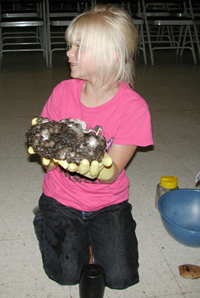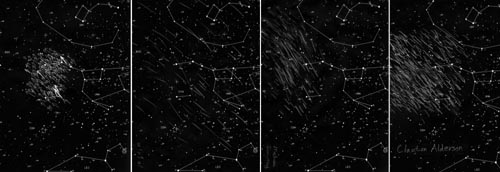Help count Leonid meteors.
Amateur astronomers interested in helping to monitor
the Leonid shower could
make an effort to collect counts of Leonid meteors in 1-minute intervals. It
takes the shower about 2 minutes to cross the United States from the East
Coast to the West Coast. With precise enough data, we can see the shower
sweep accross the country and recognize filamentary structure, if there is any.
Here
is an electronic form to report such flux measurements (on-line and off-line), designed by
Glenn Deardorf.
Lectures and talks
 "Making a comet" class
"Making a comet" class
An excercise for the class room: make a comet out of ice and dirt.
Seven year old Ashley LaFranchi participated in Jane Houston Jones' class and shows the result
in the picture to the right. Here is a recipe:
Kitchen Comets - Make a comet with this simple recipe.
"Plotting meteors from video" class.
The Sonoma County Astronomical Association "Young Astronomers" club of
kids ages 5 to 18 plotted 1999 Leonids on star charts at their club
meeting in 2000. The watched the NASA video then Jane explained meteors
in general and Leonids in particular. The young astronomers identified
the star field on the film, then plotted the meteors they observed on
official plotting forms The film they watched showed Ursa Major from
1:50 to 2:05 UTC 10/18, right at the peak of the 1999 Meteor Storm.
Here are some of their results.- Jane Houston Jones - SCAS Young Astronomer adult newsletter advisor

Figure shows plots of meteors on star charts by kids age 5-18.
"Talks" class.
Listen to Leonid MAC PI and SETI Institute astronomer Dr. Peter
Jenniskens give a
public seminar webcast on expected meteor activity and
the various Leonid MAC experiments for NASA's
Astrobiology Institute.

Public seminar for NASA Astrobiology Institute. [Nov 01, 2002]
Webcast (by NASA's QUEST program)
- lecture by Peter Jenniskens with
slides about the airborne mission (40 minutes - but skip the beginning, where I am very nervous) (Feb. '99)
Jane Houston Jones, Mike Koop, and Morris Jones have provided talks
to many Bay Area California Astronomy clubs during 2000.
Some other participants are available too
for talks and presentations. Jane first
offered to speak to clubs through the Astronomical Asociation of
Northern California (AANC) club membership. Jane is President of this
group and Morris is on the board of directors. Here's a list of the
talks given since the beginning of the year 2000.
Peter Jenniskens provided a lecture on the Leonid meteor
shower for school children at Mildenhall AFB and Lakenheat AFB in U.K. on Nov. 15, 1999.
Thursday's Classroom - NASA Space Science News for October 28, 1999.
This week's episode of Thursday's Classroom is the first of a three part series
about the upcoming Leonid meteor shower. In this first installment, lesson plans
include "Star War" (a fun game of cards to teach kids about visual magnitudes),
"Meteor Math", a classroom meteor shower simulation and more!
